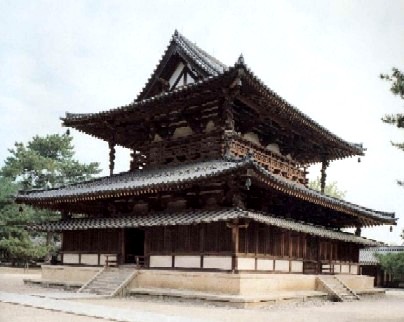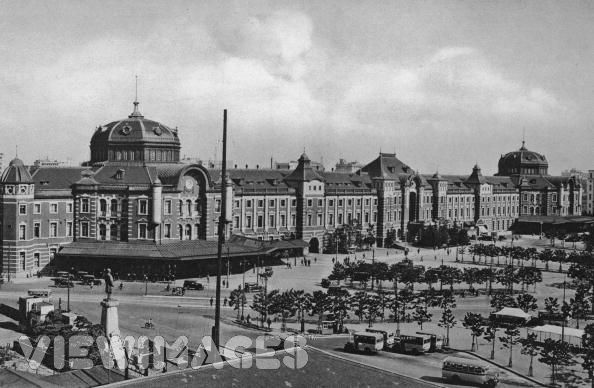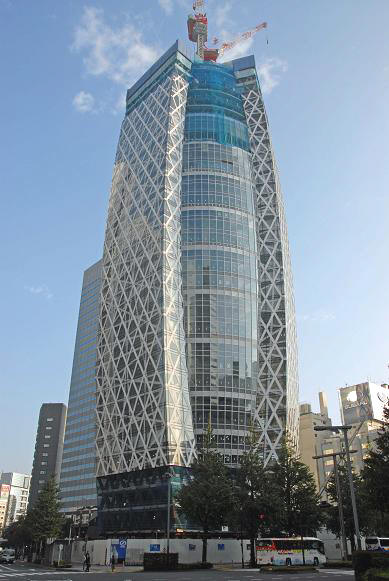~Japanese Architecture~

~History ~
Japanese Architecture has changed alot throughout history. Cultural Influences such as Japanese leaders and political power, religion, war, natural disasters, and symbolism have had dramatic impact on the various styles. Each time period has it's own unique architectural form.
*PREHISTORIC PERIOD*
Little is recorded of prehistoric Japanese Architecture, but scientists have found evidence of small buildings with thatched roofs and dirt floors, or if it was a hot and humid area, floors would be made of wood.
*The ASUKA PERIOD*
Some of the earliest Buddhist structures still exist today and are actually the oldest surviving wooden buildings in the world. The structures served as the private Temple of Crown Prince Shotoku. They are perfect examples of early Japanese Architecture. They were built in the early 7th century and consist of 41 seperate buildings. The two main structures are....
* THE MAIN WORSHIP HALL (The Kondo):

Built in the style of a Chinese Worship Hall. It was a two story structure made of post-and-beam construction with a "Hipped-Gabled Roof" with ceramic tiles.

A Hipped-Gabled Roof
*THE FIVE STORY PAGODA (Goju-no-to):

Stands in the center of an open area surrounded by a roofed cloister. The Pagoda was thought to have 5 stories because the number 5 has such a symbolic meaning in Japan. They have been thought to represent the 5 elements (Earth, Water, Fire, Wind, and Sky)
*The HEIAN PERIOD*
As Buddhism grew more powerful the priest Kukai traveled to China to study Shingon, which is another form of Buddhism. He brought this back to Japan and used the core concepts of Shingon to influence temple design. These were very spiritual and Earthy designs. The structures were built in the mountains away from the capital, and because of the different terrain, architects chose more indigenous designs like Cypress-bark roofs and wood plank floors

Later in the Heian Period, the belief in "Amida" (The Buddha of the Western Paradise) became popular. This started a trend of elegance and beauty. Some popular structures that mirrored this trend were...
*THE AMIDA HALL

Built very elegant and resembled mansions of nobility. Usually housed one or more images of Buddha
*THE PHOENIX HALL

Completed in 1053. Is a temple resembling Amida Hall. It consists of a main rectangular structure and has two L shaped wing cooridors, a tail corridor, and faces a large artificial pond. The architect, Jocho, used new techinques when designing the inside. He used multiple pieces of wood carved out like shells and joined from the inside, he applied small religious carvings to the walls, and painted the doors of scenery from around Kyoto.
*THE KAMAKURA PERIOD*
When Japanese Political power was run by Samuri, the architectural styles changed from big and elegant to simple and sturdy. Many houses were just plain, symmetrical, and contained trenches.

The Sanju-Sangen-Do
Another development of this time were tea ceremonies and tea houses. In these houses they would meet with friends, cleanse the mind, erase concerns, and enjoy the arts while receiving tea served in a gracious manner. The architecture of these houses reflected the Zen philosophy. They were rustic, rural cottages which emphasized nature with materials such as woven straw and bark-covered logs.

*THE AZUCHI-MOMOYAMA PERIOD*
This time period brought about a completely different form of architecture. In response to a militaristic time, the castle, a defensive structure, was built to keep out intruders or attackers.
*THE HIMEJI CASTLE

Commonly known as the White Heron Castle...It was a very popular castle of its time. It had beautiful curving roofs and three complex towers around the main building. It is considered one of the most beautiful structures of this time period.
*THE EDO PERIOD*
This period brought back a lot of classic Japanese architecture. The city of Edo was struck by fires repeatedly so architecture was simplified to allow for easy rebuilding. Structures were beautiful yet simple and surrounded by clusters of other houses. And Often surrounded by gardens or walking paths.

THE KATSURA-DETACHED PALACE
*THE MEIJI PERIOD*
When Emperor Meiji took charge, new and different forms of culture moved into Japan. European influences slowly managed to work their way to architecture. Government buildings and Public areas took on a more modern twist.

*MODERN JAPANESE ARCHITECTURE*

Change in technology greatly affected the architecture. After World War II a lot of Japan had to be rebuilt, but the new Japan looked much different than old Japan.
~Western building techniques, materials, and styles were brought to the cities of Japan. Materials such as steel and concrete were much different than the natural materials such as straw and wood, and are also far less flammable and destructible.
~The styles went from big, rectangular prisms to long and tall skyscrapers.
FAMOUS ARCHITECTS:
Maekawa Kunio and Kenzo Tange are two famous architects who combined Japanese aesthetic into new contemporary buildings. They returned Japanese spatial concepts, and brought back woven matts. They texturized concrete and steel, and integrated gardens and sculptures into their modern designs.
Another famous architect was Isozaki Arata, who based his designs on geometric shapes ans cubes.
 --->
---> 

Japan is really breaking the mold when it comes to architecture. It's changed greatly through out the years and they are continuing to surprise the world with their modern, unusual forms of design.

*YouTube Videos - CHECK THEM OUT!*



SOURCES:
"Japanese architecture." Wikipedia, The Free Encyclopedia. 28 Nov 2007, 20:09 UTC. Wikimedia Foundation, Inc. 2 Dec 2007 <http://en.wikipedia.org/w/index.php?title=Japanese_architecture&oldid=174439018>.
Makela, Lee. "Traditional Japanese Architecture." 27 Feb 2001. 29 Nov 2007 <http://academic.csuohio.edu/makelaa/lectures/architecture/index.html>.
See also: Japanese Architecture Issues
Japanese Architecture
Katsura Imperial Villa
Comments (0)
You don't have permission to comment on this page.